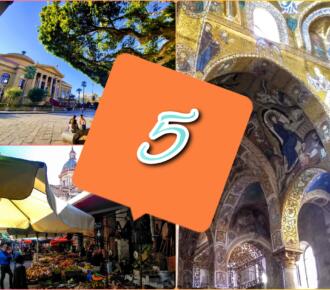5 must-see places in Palermo

Strategically located on the northwest coast of Sicily, Palermo appears as an eclectic, multi-ethnic, ancient yet modern city.
Palermo undeniably has something special; a beauty and personality that make it both splendid and “decadent”.
The city’s multicultural heritage is the natural and magnificent result not only of the different dominations, but also of the different cultures that lived in our territory. Most of them, over the millennia, have left a tangible trace; from the artistic and cultural heritage to the customs and culinary tradition.
Among the countless places to visit in Palermo, there are 5 that should not be missed. All sites are located in the historic centre of the town and are easily accessible on foot through pedestrian areas.
Please always check the opening hours, which may vary depending on the day and time of year.
- Teatro Massimo
- Martorana Church
- Dolceria” (Bakery) and the Cloister of Santa Caterina d’Alessandria
- Ballarò Market
- The Palatin Chapel
TEATRO MASSIMO
The Teatro Massimo, Italy’s largest opera house, dominates Piazza Giuseppe Verdi with its grandeur. It has a long and complex building history and after 23 years it opened its doors on 16 May 1897. At the time of its inauguration, the 7730 square metre theatre was the third largest in Europe, second only to the Opéra in Paris and Vienna. According to the initial design by architect G.B.F. Basile, the theatre could hold about 3,000 spectators, but today, due to safety regulations, the number has been reduced to about 1,300. It is also well known for its excellent acoustics and the “Symbolic Wheel” in the ceiling, made up of eleven panels that open upwards to allow ventilation of the room. The theatre is open daily for guided tours.
MARTORANA Church
Located in Piazza Bellini, the marvellous church of Santa Maria dell’Ammiraglio, a stop on my Arab-Norman Palermo tour, was only later named Martorana. Built in the Norman era by the will of the great Admiral George of Antioch (during the reign of Roger II), the church is a splendid testimony to “cultural and artistic syncretism” and to a golden age. Today it is characterised by the coexistence of different periods of activity: the splendid mosaic decorations inspired by Byzantine iconography from the medieval period and the changes made in the following centuries. The Martorana church is included in the Arab-Norman itinerary of Palermo, recognised as a UNESCO World Heritage Site in 2015.
“DOLCERIA” (Bakery shop) and the Cloister of Santa Caterina d’Alessandria
Behind a door, a place full of charm and history opens up. Thanks to the renovation project inside the former convent of the Dominican cloistered nuns, the historic pastry shop that the nuns ran for centuries has been brought back to life. In a wonderful atmosphere you can rediscover ancient flavours. Our confectionery tradition is very rich and ‘baroque’ triumphs visually but is above all a ‘delight’ to the palate. A very important role was played by the cloistered nuns. Secret recipes gave rise to rich sweets: “I sospiri di monaca”, almond pastries, “Frutta Martorana” and cassatelle just to name a few.
BALLARO’ MARKET
Palermo is its markets and street food. Palermo is also a wonderful culinary experience, unforgettable moments of smells, colours and flavours. The Ballarò market, of Saracen origin, will be a unique experience for anyone who decides to explore it. You will experience moments of local life in a unique atmosphere Our gastronomic tradition is very rich and many cultures also come into play here. Panino con panelle, crocchè, the famous arancine, panino con milza and much more.
THE PALATIN CHAPEL
Built by the king’s Roger II of Altavilla will after his coronation in 1130, it is the jewel in the crown of the Norman Palace, which dominates the oldest part of the city. Dedicated to St Peter the Apostle, it represents the meeting of the different cultures and religions present on the island in the 12th century and promoted by the Norman kings. The coexistence of Byzantine, Islamic and Latin elements has created a ‘unique’ architecture embellished with splendid mosaics. The Palatine Chapel is included in the Arab-Norman itinerary of Palermo, recognised as a UNESCO World Heritage Site in 2015.
You could visit the Teatro Massimo first; then take Via Maqueda and, after passing the Quattro Canti and Piazza Pretoria, you will immediately discover Piazza Bellini where you will find the Martorana and the ancient convent of Santa Caterina d’Alessandria. The Ballarò market in the Albergheria district is also an ideal place for a lunch break. Walk along Via Vittorio Emanuele (opposite the sea) to reach the splendid Palatine Chapel, located inside the Palazzo dei Normanni.
Author: V. Danila Castro licensed tour guide of Sicily.
